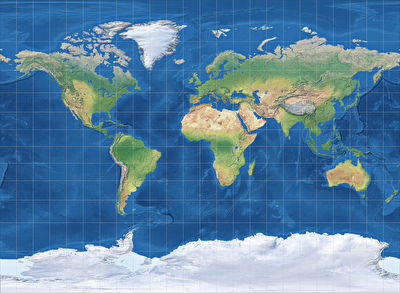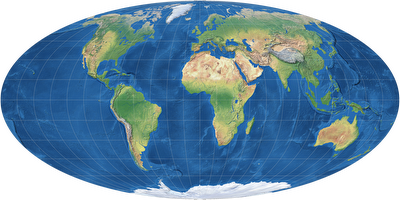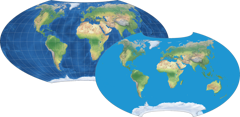What’s a Map Projection? – A brief introduction
The Earth is a sphere.
(Well, not exactly, but close enough.)
The only accurate representation of the Earth’s surface is to be found on a globe.
A globe show you the Earth as it it – reduced in size for practical reasons since most people
lack space to place a globe that is roughly 12,742 kilometers (7,918 mi) in diameter on their desktop.
But shape and proportions of the land masses and oceans, their position relative to each other, are shown correctly.
But sadly, it’s impossible to show the surface of the Earth accurately on a flat map, which was proven mathematically by Leonhard Euler in 1777. A common real world example is to imagine peeling an orange and pressing the orange peel flat on a table: The peel would bulge and break.
So this isn’t working and therefore people resorted to projections:
Imagine Earth to be translucent. Imagine you have a light source and a big (really big!) piece of paper which
is wrapped around the Earth and
serves as screen which caputeres the image that is thrown by the light source.
Have a look at the schematic illustration of the set-up.
I should make clear how a map projection (in theory) works, and why it is called projection after all.
And if you look at Greenland (the lilac island at the top of the globe and the map) you see the distortion of shape.
But the illustration is showing only one possible way to capture the image.
Depending on where exactly you place the light source, the way you wrap the piece of paper around the Earth (if you do that
at all, for you might also place it flat besides the Earth), where the screen touches the Earth (if at all), a totally different
image might be captured. And in that image, maybe Greenland isn’t distorted, but Africa is.
But most importantly, most projections doesn’t even work that way!
You cannnot construct them like that, they are build purely mathematically instead. But they are called projections nonetheless.
So you have a vast range of different ways to project the Earth’s surface to flat map, however one problem remains:
You can’t show the Earth accurately, so you try to show it approximately.
You are forced to stretch some parts of the surface, compress others, maybe bend them some. That leads to distortions.
It is important to remember that each and every world map has some kind of distortion!
But you can distort different parts if the Earth, you can choose different kinds of distortion. A specific combination of these possibilities is called a projection. And there are hundreds of different projections, each one with its own kind and positioning of distortion, in a lot of different shapes.




Left to right, top to bottom: Miller, Wagner IV, Mollweide, Canters W14.
And none of them is really accurate, none is wrong, none is better or worse than the others in itself. They are different, they serve different purposes, they aim to emphasise different aspects.
Nonetheless, you might choose the wrong projection for a special presentation – but only because it’s the wrong one for this very purpose. In other circumstances, the »wrong« projection might even be the best choice.
Back to Basic Knowledge • Go to top
Comments
3 comments
There are further comments in the german version.





Tobias Jung
the Erdi-Krausz projection is a fusion of two projections: A flat-polar sinusoidal (between 60° N and S) and the Mollweide projection (poleward). Both projections are equal-area but at different scales. Therefore, the complete map is not equal-area.
And thanks for asking, which made me realize that I never added that bit in the projection information; I’ll fix this soon!
Alexandre Canana
Alexandre Canana
Alexandre Canana
Alexandre Canana
Alexandre Canana
Alexandre Canana
Alexandre Canana
Tobias Jung
Alexandre Canana
Alexandre Canana
Tobias Jung
After all, I listed “interrupted” projections for a long time as own group here on my website. Later, I filed them under their real group (i.e. pseudocylindrical for most of them).
Alexandre Canana
Alexandre Canana
Alexandre Canana
Alexandre Canana
Tobias Jung
By the way, I’m going to add a few own equal-area fusions soon. (Well, that is… probably not before the end of January or something…)
Alexandre Canana
Alexandre Canana
Alexandre Canana
Tobias Jung
https://www.mapthematics.com/P…
Putnins P2' is identical to Wagner IV, and Wagner IV is derived by “Umbeziffern” from Mollweide. Thus, it should be able to create Hatano by applying different configuration parameters to the northern and southern hemispheres on a customizable Wagner IV, just like the asymmetrical Wagner VII.b that I introduced recently was created using the customizable Wagner VII.
Regrettably, there’s (as far as I know) currently no map projection software which offers a customizable Wagner IV…
Alexandre Canana
Alexandre Canana
Tobias Jung
https://mapthematics.com/forum…
The result doesn’t look too bad but I think it doesn’t have much advantages compared to existing pseudocylindrical or lenticular projections.
This is an umbezifferte Gringorten (“miscellaneous” class) – just a proof of concept here (i.e. I didn’t even try to find an advantageous configuration):
https://map-projections.net/de…
And yes, it’s technical possible for cylindricals as well, but in this case, you can only modify the aspect ratio and the amount of areal inflation (and you can only INcrease the inflation of the parent projection, not DEcrease is) so there’s probably not much of a point to try this.
Alexandre Canana
Alexandre Canana
Alexandre Canana
Alexandre Canana
Tobias Jung
Since it’s gone for a few years now, I don’t think it’ll return. :-(
Alexandre Canana
Alexandre Canana
Alexandre Canana
Tobias Jung
but – thank you nonetheless! :-)
Alexandre Canana
Alexandre Canana
Alexandre Canana
Alexandre Canana
Tobias Jung
I can’t remember why I filed it as Miscellanous – maybe it was simply a mistake. Thanks for pointing that out, I just corrected it.
Alexandre Canana
Alexandre Canana
Tobias Jung
And even if those questions are answered, there is probably still a bunch of projections that’ll do the job…
Alexandre Canana
Alexandre Canana
Alexandre Canana
Tobias Jung
Alexandre Canana
Alexandre Canana
Tobias Jung
ISBN-10: 0226767477
ISBN-13: 978-0226767475
Alexandre Canana
Alexandre Canana
Alexandre Canana
Alexandre Canana
Alexandre Canana
Alexandre Canana
Tobias Jung
Alexandre Canana
Alexandre Canana
Alexandre Canana
Tobias Jung
W14 used to be my favorite for a long time, but meanwhile I like the W13 and the Wagner IX optimization (W09) just as much. W11 has, despite its “wacky” shape, a great representation of the continents. Same goes for W30 (considering it’s an equal-area projection).
Alexandre Canana
Tobias Jung
Alexandre Canana
Alexandre Canana
Alexandre Canana
Alexandre Canana
Alexandre Canana
Alexandre Canana
Alexandre Canana
Tobias Jung
Regrettably, I don’t have a map projection software that can render V, VI and VII.
Alexandre Canana
Tobias Jung
Alexandre Canana
Alexandre Canana
Tobias Jung
Alexandre Canana
Alexandre Canana
Tobias Jung
For example, I always thought they’d be pseudocylindricals – because Mr. Anderson listed them as such
http://spatial.ucsb.edu/archiv…
– but now I noticed that Baranyi III to VII do not have a constant scale along each parallel, so strictly speaking, they are not pseudocylindric.
Currently, my favorites are VII, III and IV (in that order, sorted descending). But sometimes I change my mind over time…
Alexandre Canana
Alexandre Canana
Tobias Jung
I am not a lawyer, but if you want to publish a translation, you really should consult one.
Alexandre Canana
Alexandre Canana
Alexandre Canana
Tobias Jung
Yes, I thought so, because… well, if I’d translate anything, it would be either FROM my native language to English (e.g. Wagner’s text or Frančula’s 1971 paper) or TO my native language. So I just assumed you’d do the same… :-)
Alexandre Canana
Alexandre Canana
Tobias Jung
Alexandre Canana
Alexandre Canana
Tobias Jung
Of course I need a software that can render them, and usually I only add projections that are useful (in one way or another) for world maps, although there already may be a few exceptions…
Which azimuthal projections specifically do you feel are missing?
Alexandre Canana
Alexandre Canana
Alexandre Canana
Tobias Jung
Ginzburg I and II: Yes, I guess I will add them at some point.
Gnomonic projection: Probably not because it’s really not suited for world maps (or even hemispheric maps).
Orthographic projection: Hmmm. It only shows less than a hemisphere, in my opinion, there’s too much missing for useful comparisons.
Alexandre Canana
Alexandre Canana
Alexandre Canana
Alexandre Canana
Tobias Jung
Alexandre Canana
Alexandre Canana